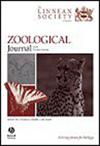Osteology and phylogenetic position of Plagiosaurus depressus (Temnospondyli: Plagiosauridae) from the Late Triassic of Germany and the repeated loss of dermal bones in plagiosaurids
IF 3
2区 生物学
Q1 ZOOLOGY
引用次数: 0
Abstract
The skull and postcranium of the Late Triassic plagiosaurid temnospondyl Plagiosaurus depressus from Halberstadt (Germany) are redescribed in detail. Plagiosaurus possesses two autapomorphies, the abbreviated tabular and the broad contact between the postorbital and parietal. A comprehensive phylogenetic analysis of Plagiosauridae finds a clade Plagiosaurinae consisting of Plagiosaurus and Gerrothorax. Among other characters, both taxa share the solid box-like sides of the low pectoral girdle, the short but robust humerus with small deltopectoral crest and well-developed supinator process, and an anterodorsally directed lateral line sulcus close to the mandibular symphysis. Compared with Gerrothorax, the skull of Plagiosaurus is deeper and more slender, and the postfrontal is absent, meaning that the parietal forms the posteromedial margin of the enlarged orbit. This new interpretation of the bone configuration shows that reduction of circumorbital bones associated with orbital enlargement occurred three times independently within Plagiosauridae, albeit probably in different functional contexts. Our phylogenetic analysis further reveals the Plagiosuchinae (Plagioscutum + Plagiosuchus) as the most basal plagiosaurid clade, which, in turn, forms the sister group to Plagiosaurinae and Plagiosterninae (Plagiorophus + (Plagiosternum + Megalophthalma)). The mentioned shared derived characters of Plagiosaurinae in the pectoral girdle, forelimbs, and mandibular lateral lines suggest a similar benthonic lifestyle.德国三叠纪晚期钝角龙(Temnospondyli: Plagiosauridae)的骨骼学和系统发育位置以及钝角龙类真皮骨的反复丢失
本文重新详细描述了出土于德国哈尔伯施塔特(Halberstadt)的晚三叠世斑龙类天鼻鼻龙(Plagiosaurus depressus)的头骨和后颅骨。Plagiosaurus拥有两个自体,即简略的表骨和眶后与顶骨之间宽阔的接触面。通过对矛角龙科进行全面的系统发育分析,发现矛角龙科(Plagiosaurinae)由矛角龙属(Plagiosaurus)和矛角龙属(Gerrothorax)组成。除其他特征外,这两个类群的共同特征包括:低胸腰的两侧呈实心箱状;肱骨短而粗壮,具有小的胸骨下嵴和发达的肱骨上突;靠近下颌骨骨骺处有一条前背向的侧线沟。与Gerrothorax相比,Plagiosaurus的头骨更深、更细长,而且没有额后骨,这意味着顶骨构成了增大的眼眶的后内侧边缘。对骨骼构造的这一新解释表明,与眼眶增大相关的眶周骨骼减少在犁鼻龙科内独立地发生过三次,尽管可能是在不同的功能背景下发生的。我们的系统发育分析进一步揭示了长颈龙科(Plagioscutum + Plagiosuchus)是最基干的长颈龙类支系,而长颈龙科与长颈龙科(Plagiorophus + (Plagiosternum + Megalophthalma))又是姊妹群。所提到的胸腰、前肢和下颌侧线上的共同派生特征表明,Plagiosaurinae 具有类似的底栖生活方式。
本文章由计算机程序翻译,如有差异,请以英文原文为准。
求助全文
约1分钟内获得全文
求助全文
来源期刊
CiteScore
6.50
自引率
10.70%
发文量
116
审稿时长
6-12 weeks
期刊介绍:
The Zoological Journal of the Linnean Society publishes papers on systematic and evolutionary zoology and comparative, functional and other studies where relevant to these areas. Studies of extinct as well as living animals are included. Reviews are also published; these may be invited by the Editorial Board, but uninvited reviews may also be considered. The Zoological Journal also has a wide circulation amongst zoologists and although narrowly specialized papers are not excluded, potential authors should bear that readership in mind.

 求助内容:
求助内容: 应助结果提醒方式:
应助结果提醒方式:


